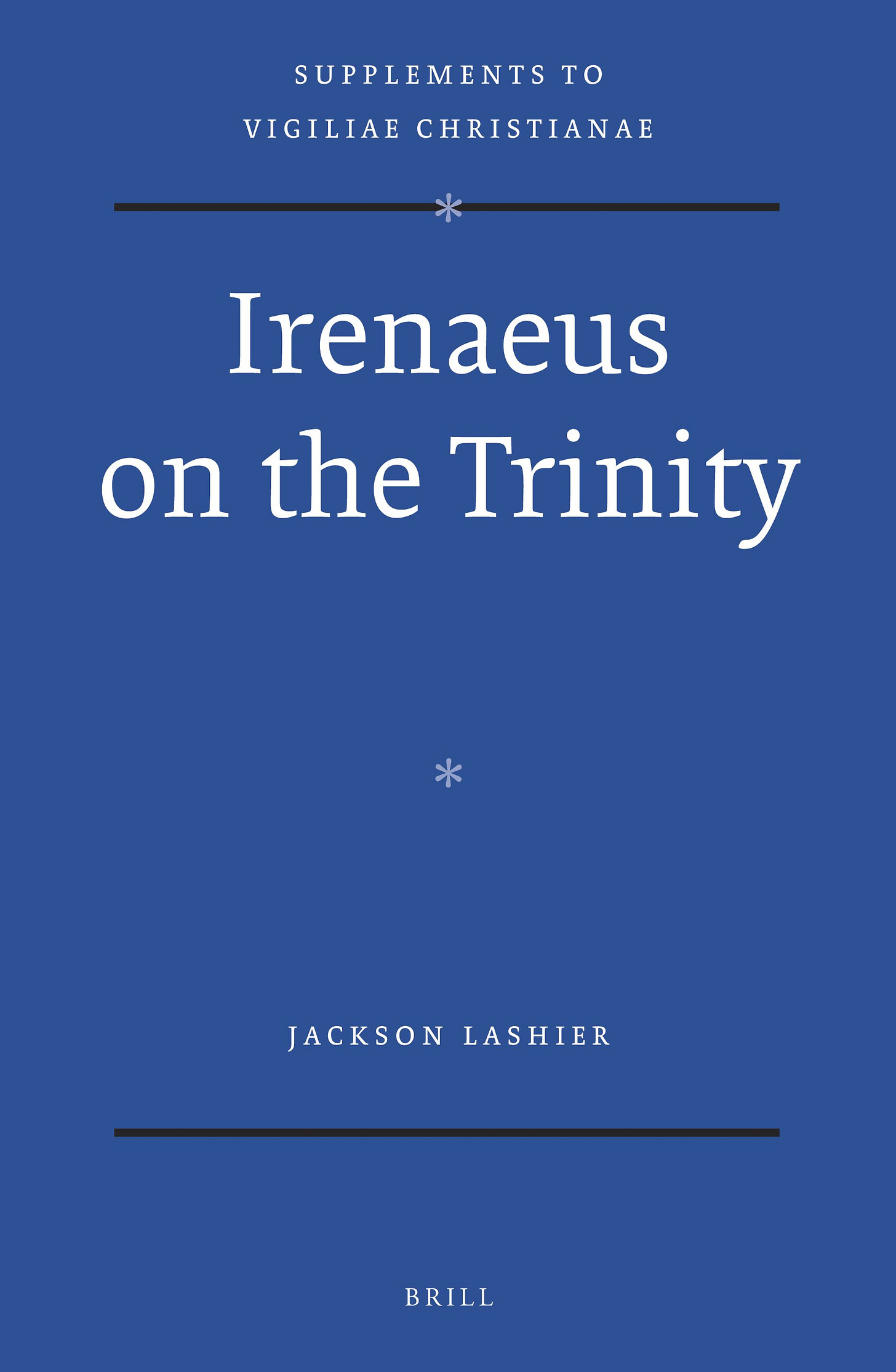Irenaeus on the Trinity
Jackson Lashier (Leiden | Boston: Brill, 2014), 267 pp.
Trinitarian apologists are often accused of quote-mining the patristic authors for anything that seems to bear a resemblance to succinct formulations of the doctrine of the Trinity in later, pro-Nicene writers. The fact is, however, that while some Christian apologists engage in that kind of superficial reasoning, not all of us do. Some of us go back to the sources themselves and then diligently search contemporary scholarship to gain a better understanding of how they and their colleagues interpret the fathers, and why they it is they affirm or deny that a given father holds to one of the cardinal doctrines of the faith. Some of us understand that scholarship often times is driven by philosophical commitments that are assumed to be true and, therefore, are functioning as the grounding of all subsequent conclusions surrounding the church fathers and what they could or could not have known and, by implication, what they did or did not teach directly or indirectly in their texts. The doctrine of the Trinity is one of those doctrines whose complexity over time has led unbelieving scholars to conclude that it is not deducible from the Scriptures but was, instead, the hybrid offspring of Neo-Platonism and Aristotelianism as funneled through later church fathers who would write on the subject. But as Jackson Lashier’s book Irenaeus on the Trinity makes evident, this is not the case.
In fact, Lashier’s work helps us see that the closer one’s theology is tied to the Scriptures, the more clear he is in articulating what is essentially a pre-Nicea pro-Nicene form of Trinitarianism, complete with a distinction between the ontological and economic Trinity. By contrasting the philosophical terminology of Justin Martyr, Athenagoras, and Theophilus of Antioch surrounding the ad intra and ad extra personal relations of the Father and Son and Holy Spirit to one another with Irenaeus’ Biblically constrained language of God’s “two hands,” one readily sees that the former is more prone to misinterpretation than the latter. That is to say, the earlier fathers’ language regarding the Son and the Spirit as the 2nd and 3rd divine “entities” lent itself to the ontological subordinationism and hierarchy within the divine essence/Godhead that Irenaeus’ Gnostic opponents had built into a complex hierarchical ontology of aeonic emanations. Thus, Lashier argues that Irenaeus’ departure from the nomenclature of Justin, Athenagoras, and Theophilus (in most cases) is not due to his lack of a doctrine of the ontological and economic Trinity (a claim which some scholars have advanced over the past 100 years or so), but is due to his desire to employ the language of Scripture in order to avoid bearing a superficial resemblance to the subordinationist theology of the Gnostics.
What is more, by avoiding the Platonic notion of orders of being, or ranking of being, Irenaeus is able to show the equality of the divine persons from the Scriptural teaching that creation, redemption, and restoration are all solely the works of God, and yet they are acts attributed to the Father and the Son and the Spirit. The Father and Son and Spirit all create, all redeem, and all restore – they are perfectly equal, differing only in their ad intra and ad extra relations to one another.
Lashier is, of course, careful not to use later terminology developed at Nicea and beyond, lest his readers suppose he is reading back into Irenaeus’ writing orthodox Christian doctrine that wouldn’t come into being until a few hundred years later. Rather than speaking of the ad intra and ad extra relations of the divine persons, Lashier speaks of Irenaeus’ understanding of the relation of the divine “entities” to one another in creating, redeeming, and restoring all things. This is helpful not only in clearing Lashier of any charges that he is reading back into Irenaeus, but also in understanding that the specific terminology could very well be changed without affecting the substance of the doctrine. This means that Irenaeus’ doctrine of the Trinity may be translated without much difficulty into Nicene terminology, which further implies that the closer the fathers remained to the Scriptures, the more clearly they articulated a doctrine of the Trinity that is nearly identical to what we find articulated in the later in church history by pro-Nicene theologians.
Some attention is paid to the hermeneutical practices of each of these early church teachers, with some attention also given to several key texts which have a long history of being interpreted as articulating the doctrine of God’s Triunity, despite being parts of the Old Testament. For instance, the presence of the Voice of God in the garden of Eden is identified as the Logos, as is every instance of God personally speaking to individuals face to face (e.g. Abraham, Jacob, Moses, Manoah, Samuel, etc). Similarly, Abraham’s meeting with Yahweh at the tents of Mamre (cf. Gen 18) was interpreted as the Lord meeting with his two “angels,” or “two hands,” an interpretation that is found much later in St. Augustine’s De Trinitate as well.
Unlike the philosophical depictions of the Trinity given by Justin Martyr, Athenagoras, and Theophilus, Irenaeus’ exposition of the Scripture brings the three persons into relief, compromising neither their undivided essence and attributes nor their distinct relations to one another (ad intra) and toward creation (ad extra). Irenaeus on the Trinity is a helpful tool for the scholar, or pastor, or academically inclined Christian who wants to deepen his knowledge of church history and its more well known figures. It also is helpful in providing Christians with an understanding of how the church fathers approached Scriptural interpretation, a process which involved interpreting all of Scripture in light of all of Scripture.
—h.





